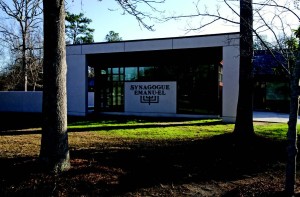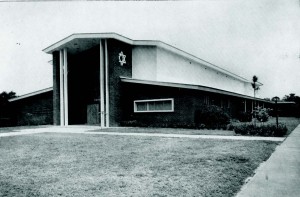Emanu-El History
Synagogue Emanu-El at 60
5 Windsor Drive
Charleston, SC 29407
 Charleston’s Synagogue Emanu-El celebrated its 60th anniversary on November 11, 2007, with a huge gala in the newly refurbished Zucker Social Hall. A sold-out crowd enjoyed an evening of magnificent décor, marvelous food, and exciting entertainment. The event commemorated six decades of congregational life, and also culminated several years of planning for and construction of Synagogue Emanu- El’s new addition and renovation.
Charleston’s Synagogue Emanu-El celebrated its 60th anniversary on November 11, 2007, with a huge gala in the newly refurbished Zucker Social Hall. A sold-out crowd enjoyed an evening of magnificent décor, marvelous food, and exciting entertainment. The event commemorated six decades of congregational life, and also culminated several years of planning for and construction of Synagogue Emanu- El’s new addition and renovation.
Emanu-El traces its history back to the summer of 1947 when a group of members from Orthodox Brith Sholom met to discuss the possibility of either converting the congregation from Orthodoxy to Conservative Judaism or breaking away to form a Conservative synagogue. The consensus of the group was to break away. The Kronsberg and Steinberg families, along with Nathan Goldberg, Milton Banov, and Hyman Rephan, formed the active nucleus within a group of 73 other charter members. Macey Kronsberg became the first president, and within a few months, land was purchased. Matthew “Mattie” Steinberg’s family contributed a surplus Army chapel to be used as a sanctuary, and the congregation hired its first rabbi, Lewis Weintraub.
During this time, the ladies of the congregation blossomed. Sisterhood Emanu-El was formed, with Anita Steinberg as its first president. The Sisterhood established a Sunday school and over the years has raised funds to help support the many activities and rituals in the synagogue. Alan Rubin was the first Bar Mitzvah, and Barbara Steinberg (Spitz) was the first to be confirmed. JoAnn Steinberg was the first bride to be married at Emanu-El.
 In the early 1950s, Leon Steinberg purchased a site off Highway 61 for use as a cemetery. Recognizing that the synagogue was rapidly outgrowing the Army chapel, congregants formed a committee to raise money to buy land and erect a new building. Ed Kronsberg, Irving Steinberg, and Hyman Rephan took on the fundraising challenge. An architect was hired who designed a cathedral-like sanctuary big enough to hold 1000 members. The builders broke ground in 1954 and on December 18, 1955, the congregation moved into its new home on Gordon Street in Wagner Terrace. Rabbi Gerald Wolpe took the helm, serving as spiritual leader for four exciting years. Wolpe was succeeded by several other rabbis. In 1964, Rabbi Jordan Taxon joined Emanu-El’s family and stayed in Charleston for ten years. Known as “Mister Fix-it,” Rabbi Taxon was “as comfortable with a hammer in his hand as a siddur,” remembers a current member. The synagogue thrived on Gordon Street.
In the early 1950s, Leon Steinberg purchased a site off Highway 61 for use as a cemetery. Recognizing that the synagogue was rapidly outgrowing the Army chapel, congregants formed a committee to raise money to buy land and erect a new building. Ed Kronsberg, Irving Steinberg, and Hyman Rephan took on the fundraising challenge. An architect was hired who designed a cathedral-like sanctuary big enough to hold 1000 members. The builders broke ground in 1954 and on December 18, 1955, the congregation moved into its new home on Gordon Street in Wagner Terrace. Rabbi Gerald Wolpe took the helm, serving as spiritual leader for four exciting years. Wolpe was succeeded by several other rabbis. In 1964, Rabbi Jordan Taxon joined Emanu-El’s family and stayed in Charleston for ten years. Known as “Mister Fix-it,” Rabbi Taxon was “as comfortable with a hammer in his hand as a siddur,” remembers a current member. The synagogue thrived on Gordon Street.
In the ’60s and ’70s, the majority of younger members moved to neighborhoods west of the Ashley River. A young rabbi, Charles Sherman, was hired 1974 to replace Rabbi Taxon. Sherman was a dynamic community leader who fought against the development of Kiawah Island by Kuwaiti businessmen. As the congregation continued to grow, the younger contingent wanted Emanu-El to relocate west of the Ashley, but those still living around the synagogue opposed the move. Through quiet persuasion and a memorable Yom Kippur sermon, Rabbi Sherman convinced young and old alike that it was time for a change.